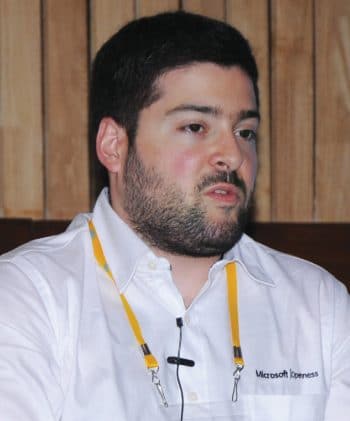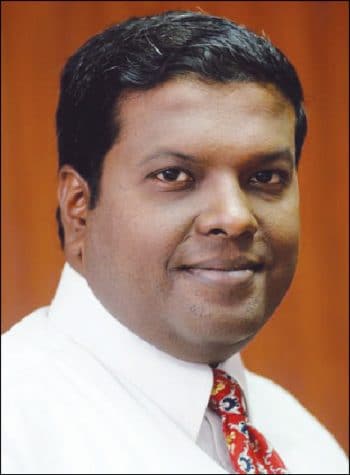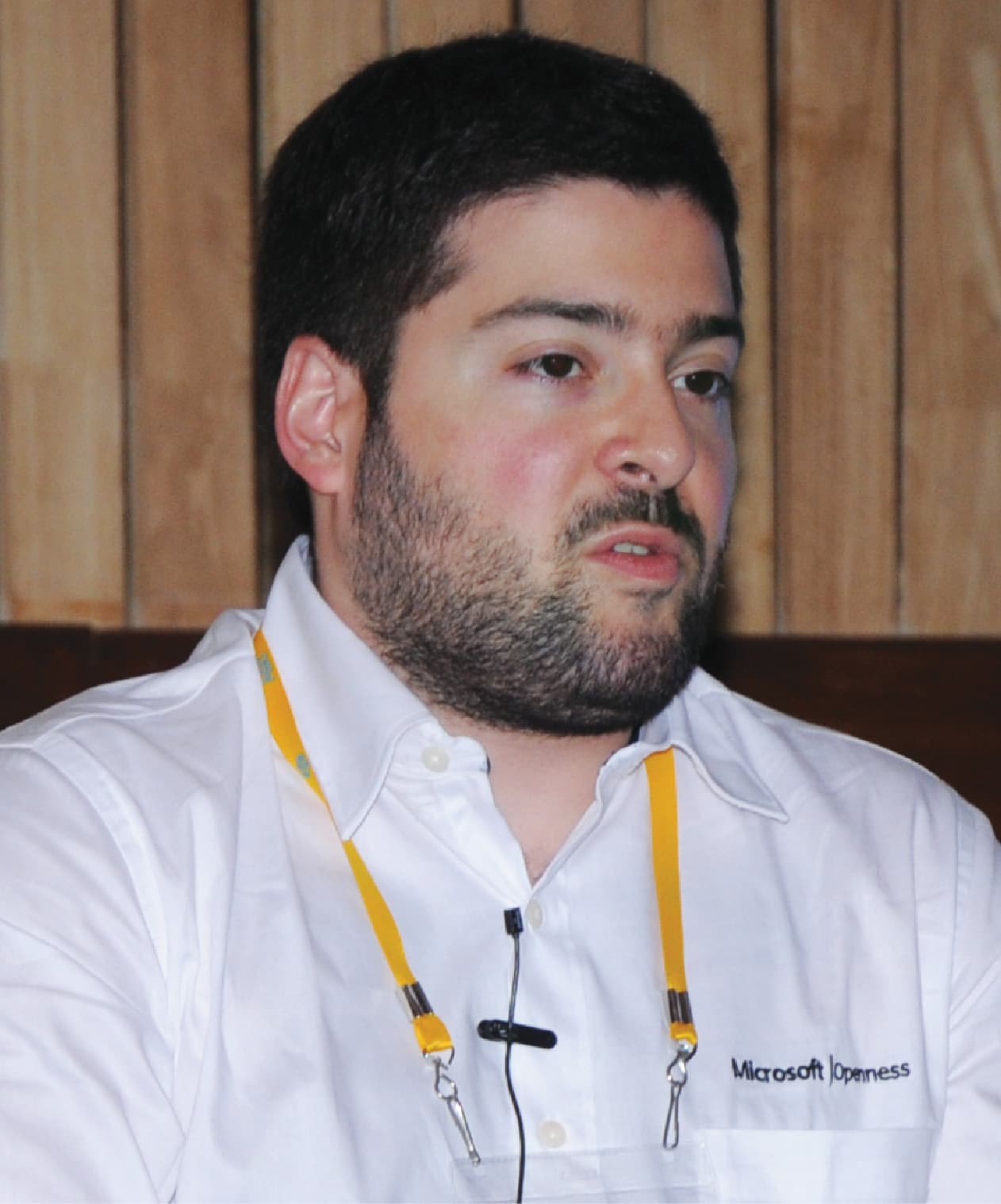
RC: How was the whole OSI experience for you? How did you find the levels of engagement here
José: It’s a strong community — very active and very engaged. I have been sitting at the booth and getting a lot of pointed questions. People really want answers on important topics, like Microsoft and open source. I think questions about the strategies, motivation, investments and role models are important; these are questions that I want to answer. I came across a very inquisitive and curious community, which is really good. People have a strong focus on the cloud, though. I think there are two to three big areas of open source development now, like application containers, etc, but in the end, everything comes under the cloud and IoT, as well.
This event is a great intersection in terms of topics and the community. The most important thing to have at an event like this is the vendors. We have kind of nurtured our open source ecosystem with the help of vendors. Ours was a company that released one product in three years, and now we are able to release a product every week.
RC: Did you sense scepticism in their questions, or was there genuine interest?
Balaji: I have been coming here for the past two years, and now, I can see the change. There is a change towards Microsoft’s association with the open source community, but have we reached where we really want to be? Not yet! They are informed about what we are doing but they want to know what’s next! About 10-15 people visiting our booth asked me what we meant by ‘Microsoft plus Linux’. They are wondering what we do with Linux. There is a large part of that whole open source ecosystem, which doesn’t still understand that we have moved as a company, and that Microsoft has changed as an organisation. That’s the message we are trying to spread since the past few years, and that message still needs to reach the right audience. I think in the past couple of years, we have moved up with the cloud and with our Azure platform. It’s not by chance but by design, as we have consciously built Azure as a platform on which you can pretty much build whatever you want. We just want people to know that Microsoft loves Linux. So scepticism, yes, we do get that! And we would like to remove it. It’s a journey, and we are still on the way!
José: Scepticism is not what we want, and what we can do working in this company is to inform, teach and learn. So awareness plays a big role and we are going to let facts speak, for example, by telling people that you can build anything with open source, etc. Here, it is important to say that our journey of open source is incomplete. It is an ongoing journey; we aren’t perfect and we still have many things to work out. I also want to say that this is the first time we are being loud about there being CEO level attention on this topic, and that we feel comfortable about this decision (of adopting open source). This journey isn’t new though. I have been in this company for five years now and the strategies were already there. So it is probably seven to eight years that Microsoft has been doing this. We did not have the cloud back then but we were talking about open source. We still talk about it, but now we have introduced our own cloud and we’ll add more things, as they come about. I think that’s important as well. The other thing is that there are many teams looking after this open source strategy from many different aspects. We have engineers, a dedicated sales and marketing team, business technologists and evangelists. We have all of that, so it’s not an isolated silent strategy of Microsoft’s, but is something we are embedding in our day to day activities.
RC: What does it mean to be a CTO of a tech centre in Microsoft? Typically, a CTO defines all the technologies being adopted or being worked upon within an organisation, but this is a particular group, here. Can you share something more about your role?
José: Well, my role here is to help the traditional Microsoft business to understand the technological ecosystem.
RC: Is it more of an ‘inward’ role?
José: Right! I do a lot of internal evangelism, with the traditional, conventional, sales and marketing groups at Microsoft, etc, to help them understand the open source philosophy, the emotions that drive the community, how it works and also to understand the emerging technologies well. So it’s just not about the technology for business, but integrating an open source ecosystem with the traditional Microsoft business, which has been very successful in serving technology for many, many years. We needed this traditional business to be very successful in selling open source too. That’s what my role is about — I have to work very closely with the engineers. I am an open source developer myself, but I don’t get hands-on with the products. I also have to be active with what we call a ‘field’, where my colleagues attend conferences in many countries, like Open Source India. We go there, talk to the community, and build a relationship with them. I am also connected externally, with the media or the companies that want to do business with us.
RC: Your profile mentions that you also created a national distro for Venezuela. So how do you now see it? Do you think that countries need to have their own distributions?
MS: Do you think that there is a need for a national distribution of Linux in India as well?
José: My work was with Canaima, which is the national distribution of Venezuela, before I joined Microsoft. It is what I am passionate about, because it uses many open source technologies. I have been working on Linux for many years and, obviously, on some other models as well. It’s a beautiful project in terms of the reach, and I think any technology that democratises access and reach is important. Giving you my personal perspective on this is tricky since I am sitting here as a Microsoft head. But, generally speaking, from Microsoft’s perspective, governments have always been very open to the policy of technology including the policy for open source. In the last two weeks, if you look at the conversation we are having in places like the US, we are actually looking into how we can help drive the open source policy. And I think it has to be a win-win scenario where we can help in successfully developing this interest in open source. At the same time, we also believe strongly that our products have immense potential, so whether they are proprietary or not, they are often the best fit in many cases. So we have that balance. The open source ecosystem is very vague and diverse, which is something that you cannot control. It has always offered thousands of different ways in which people can fix a problem.

Balaji: I have been fairly involved in working with a number of people in India, in C-DAC, NICA, etc. There are some primary questions that I think we need to think about before taking a call on that. It’s good to have open source, but we need to maintain some records. For instance, let’s assume you build an open source platform and there is no company supporting that code. And we build an operating system on it called X, version 3.1. Twenty years later, the OS has gone to X.x and moved to version 21. At that stage, is the community aware that the code was built on version 3.1? I am just saying that the government or certain bodies need to think about a few more things, because proprietary firms like Microsoft commit to their end users that they will support any version, immaterial of how many versions there are. Today, you can still open your file on Microsoft Office 2001, for example. So there are a few key things that need to be really thought about, and then systems must be formalised to make sure that the support is going to be there. We want the government to be more proactive on this front.
MS: Talking about Microsoft supporting Linux, people are still surprised with this news. Any message for them?
Balaji: Absolutely. We are not saying we have adopted Linux, but we support open source completely. You can run Linux as a first class guest, if you are committed as a first class citizen on our cloud platform. If we go back to KY Srinivasan, ex partner architect at Microsoft, he is probably the single largest provider of code to the Linux kernel today. He has contributed 20,000 lines of code and he is a Microsoft employee; so that’s our commitment with Linux. The things that we are doing are more open in other ways too, not regarding just the source code, but also with regard to the community.
RC: So is there a major change in the environment at Redmond with the change in leadership? Steve Ballmer was never seen as someone who was in love with open source. With Satya Nadella taking over, is there a change or, rather, what is the change?
José: We have seen acceleration in the internal awareness, like in the engagements (with customers, technologists, etc) and conversations, which Microsoft now feels much more empowered to have. Investments in open source have always been there, and have been there for many years. So that’s what I think has accelerated. We have a fairly mature open source strategy, though it’s not perfect, as I mentioned. But we really want to strive towards leadership in many areas (like containers) — that still requires a lot of maturity and many years of discussion, simulation, gathering customers’ insights, decision making, etc. I think people are now getting to know what open source is. It’s a journey of discovery.
RC: Is there a strategic road map for coming out with an open source project of the scale of Android, which Google rolled out?
José: Something that is already out there is the .NET framework, which is strategic and has the whole ecosystem around it. When you think of .NET, you also think about the new research technology coming out like the F Sharp programming language — completely new products but you can still connect to your .NET libraries and USBs. This is the magnitude of Microsoft’s open source commitment. Our developers are incredible. There are troops of people who have done really amazing things with .NET.
RC: With respect to the Azure Marketplace, are there any specifics that might impact developers and vendors that you would like to share?
José: There are traditional partners who are highly successful, and then there are disruptive IT companies or the cloud service vendors and many others from markets like India, etc. We really want to connect the latter with the financially big partners to help them grow — in India, China, various other parts of Asia, Latin America, Middle East and Europe. So how do we help them? The answer is the Azure Marketplace. You now have a solution — you have a portal that can control the Linux machines running on Azure, etc. Vendors and service providers just need to put their products on Azure Marketplace and sell them to the big companies — one never knows who it’s going to be. It could be Hitachi, 3M, etc, so Azure Marketplace is a lot about connecting with the enterprise customers across the globe. To do that, we need to really make the marketplace global, which is what we’ve done with Azure.
RC: Are there multiple marketplaces that Microsoft has built? Are these integrated or does one have to go to each one separately?
Balaji: Currently, we have three independent marketplaces. One for the cloud, one for the phone, and one for the desktop. But our roadmap for Windows 10, which is what we now have, is that the Windows Phone and Windows Operating System will merge. So basically, it’s one store for the phone and desktop (devices), and one for the cloud.
RC: Is there a revenue sharing model in Azure Marketplace?
José: In the cloud, the economics is slightly different because we are not selling an application on our competitor’s platform — we are selling it in ours. Vendors and service providers pay us for the storage and the network.
RC: Containers are thought to be hot in the development environment. Can you enlighten our readers about what containers are?
José: Think of containers as application-specific silos; so we currently have a silo called VM, an operating system with one or many applications. It also contains some overhead, as an OS has to run along with supporting services. Those running an application do not really care about all these things. Also, when you’re trying to deliver a business, the customers shouldn’t be paying for or worrying about that overhead. So a container removes that overhead and focuses on the application, which has pros and cons and the limitations of that model. The container uses the host operating system by creating an operating system within itself. The application is not penalised because there is an operating system involved. Customers are really interested in splitting their applications into micro applications, and you can move those containers around, etc.
If you really don’t care about the overhead, Azure is the perfect fit. We can provision that fabric for you. It’s really simple, you don’t have maintain it, and it integrates Docker with Azure.
RC: Do you think that the need for an IT pro or an IT manager would reduce because that level of skill has actually been taken over by the containers and the VMs?
José: For the first time, the IT pro can go back and focus on the business. The presence of Cloud does not affect IT at all but it just means that you don’t have to guard your operating system any more.
MS: Coming back to the event, you have come here especially to attend it. How was your experience?
José: It’s been personally gratifying to come here. I have learnt a lot while talking to the people, and it is such a strong community. I am particularly honoured to be a part of the conference and we’ll continue doing this with you as we really feel welcomed. Having people join us for the hands-on labs that we had at our booth has been really rewarding. I am enchanted with the IT ecosystem in India and how passionate people are about technology. I think India is ahead of the curve in open source and I am glad to be here. What I like the most is the focus on the cloud, as a community. Five years ago the open source community was still trying to figure out what the cloud was about, and then it was open source that charted the path forward. I like the focus and I like the fact that we are not talking about only Linux here, or Android, or only Eclipse — it’s not product-centric, it’s open source. I think that’s what drives so many people here. And like I said before we started this conversation, this is the right place to be!










































































